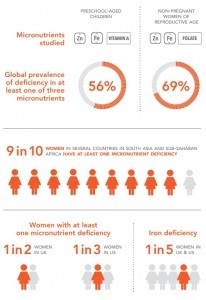The study, published in The Lancet, revealed that more than half of preschool-age children and over two thirds of non-pregnant women of reproductive age worldwide have a micronutrient deficiency.
Thank you for reading this post, don't forget to subscribe!The researchers in the Lancet study looked at data for deficiencies in iron, zinc and vitamin A in preschool-age children, and iron, zinc, and folate in non-
pregnant women of reproductive age.
The resulting data reveals the burden of deficiency in at least one micronutrient was 56% for children and 69% for women. Levels of malnutrition were at their worst in the developing world but were also widespread in high-income countries.
The review was led by the Global Alliance for Improved Nutrition (GAIN) and the Micronutrient Forum (MNF). Following publication, GAIN and MNF said there was now an “urgent” need for action and that their findings suggested the widely held belief that there are 2 billion people globally suffering with a micronutrient deficiency is likely to be a “major underestimate”.
They state: “We estimate that there are 372 million (95% uncertainty interval 319–425) preschool-aged children (aged 6–59 months) and 1·2 billion (1·0–1·4) non-pregnant women of reproductive age (aged 15–49 years) with one or more micronutrient deficiencies worldwide. This approach provides a transparent method for estimating the global and regional prevalence and can be replicated as more and better data from nationally representative surveys become available.”
As a result of these findings, IADSA (International Alliance of Dietary/Food Supplement Associations) has launched a new resource named ‘Wake-up Call: Experts sound the alarm over micronutrient deficiencies’, which explains the key conclusions from the study and explores how best to address the issues raised.
“The significance of this review cannot be overstated,” said Cynthia Rousselot, IADSA’s Director of Technical & Regulatory Affairs, “It indicates that micronutrient deficiencies are more widespread than we originally feared. Malnutrition can result in health and developmental problems and reduced educational outcomes. It is up to all of us to find ways to address this hidden hunger, including better integration of supplement programmes into nutrition and health policy.”
Authors of the review point out some of the serious consequences that can result from micronutrient deficiencies, including: Compromised immune systems, constrained physical and cognitive development, increased risk of diabetes and heart disease, reduced educational outcomes, and limitations on ‘human potential’.
Some measures identified by GAIN and MNF to address the problem include: fortification of food with vitamins and minerals, and supplementation programmes.
In its own information resource, GAIN states: “We call for a new global mobilization across all sectors—including donors, researchers, policymakers, program implementors, private sector, and civil society—working in partnership to address and prevent micronutrient deficiencies worldwide. Micronutrient deficiencies compromise immune systems, burden health systems, and limit human potential worldwide. As a global community we cannot afford for the next generation to grow up without access to the nutrients they need to develop and thrive.”
The researchers note that they could only focus on preschool-age children and women of reproductive age for their analysis because insufficient data currently exists for other groups, including school-aged children, adolescent boys, men, pregnant women, and older adults. They says this highlights the urgent need for more and better data on malnutrition across all population groups.
The Review
The discussed analysis followed seven steps. First, authors established consensus on a set of sentinel micronutrients and their biomarkers that should be included in the analysis.
Second, they identified, reviewed, accessed, and included population-based, individual-level biomarker datasets containing at least two of six sentinel micronutrients.
Third, they adjusted the micronutrient status biomarker concentrations for inflammation, where applicable, using the Biomarkers Reflecting Inflammation and Nutritional Determinants of Anemia (BRINDA) approach and applied thresholds to identify individuals with deficiencies in each micronutrient.
Fourth, they identified three core micronutrients each for preschool-aged children and non-pregnant women of reproductive age from the six sentinel micronutrients.
Fifth, they included the data sources that measure at least two of the three core micronutrients for preschool-aged children and non-pregnant women of reproductive age in the global and regional analysis.
Sixth, they applied regression models to estimate the prevalence of deficiency for the unmeasured micronutrient when only two of the three core micronutrients were measured.
Finally, the authors applied statistical models to estimate the global and regional prevalence of and number of preschool-aged children and non-pregnant women of reproductive age with deficiencies in one or more core micronutrients.
They grouped data into six geographical regions of low-income and middle-income countries (east Asia and the Pacific, Europe and central Asia, Latin America and the Caribbean, Middle East and north Africa, south Asia, and sub-Saharan Africa) and we included high-income countries in a seventh group.
Source: The Lancet
DOI:https://doi.org/10.1016/S2214-109X(22)00367-9
“Micronutrient deficiencies among preschool-aged children and women of reproductive age worldwide: a pooled analysis of individual-level data from population-representative surveys.”
Stevens, G. A., Beal, T., et al.


